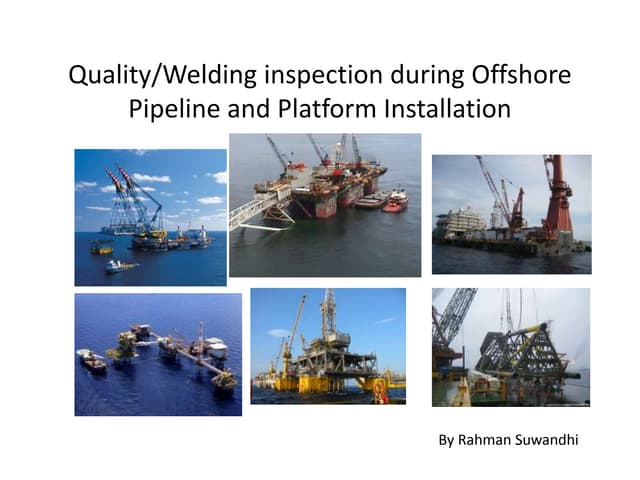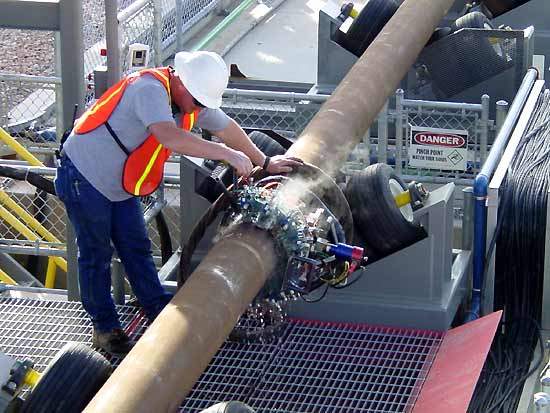Comprehensive Pipeline Welding Inspection: Protecting Framework Stability
Comprehensive Overview to Pipeline Welding Inspection: Making Sure Stability and Security in Pipe Building And Construction and Maintenance
The stability and security of pipes are critical in today's facilities landscape, emphasizing the critical function of welding examination in pipeline construction and maintenance. Pipeline Welding Inspection. The complexities included in welding examination raise relevant concerns about market requirements and the progressing modern technologies that may redefine these practices.

Relevance of Welding Examination
Welding inspection plays an important duty in making certain the stability and security of pipe systems. It works as a basic procedure that verifies the high quality and reliability of bonded joints, which are usually one of the most at risk points in pipe building. Via organized examination, assessors can identify prospective problems such as splits, porosity, and incomplete fusion, which may jeopardize the structural stability of the pipe.
The relevance of welding examination prolongs past plain compliance with market standards; it also safeguards public wellness and the atmosphere. If failings happen, pipes lugging dangerous products position considerable dangers. Reliable assessment procedures help avoid ruptures and leaks, alleviating environmental damages and shielding communities. Moreover, detailed inspections can improve the longevity of pipe systems, lowering the demand for costly repair services and downtime.
In addition to making sure safety and security and compliance, welding evaluation promotes a society of high quality assurance within companies. By focusing on evaluation throughout the welding procedure, business can develop an online reputation for integrity and quality, ultimately bring about increased customer confidence and company possibilities (Pipeline Welding Inspection). Hence, the significance of welding assessment can not be overstated in the context of pipe construction and upkeep
Key Welding Procedures
Different welding processes are utilized in pipeline building and construction, each with its own benefits and applications. Among the most widely utilized methods are Secured Steel Arc Welding (SMAW), Gas Tungsten Arc Welding (GTAW), and Gas Steel Arc Welding (GMAW) SMAW is favored for its adaptability and capacity to perform well in various environmental problems, making it suitable for area applications.
GTAW, often referred to as Tungsten Inert Gas (TIG) welding, is recognized for its capacity to create high-quality welds with outstanding control over warm input, making it optimal for thin-walled pipelines and stainless-steel materials. GMAW, or Steel Inert Gas (MIG) welding, offers high deposition rates and is efficient for massive projects, typically employed in the fabrication of pipes in controlled atmospheres.
In Addition, Submerged Arc Welding (SAW) is made use of for its deep infiltration and high performance, specifically in the construction of large-diameter pipelines. Each of these processes contributes to the general stability and safety and security of pipeline buildings, making it possible for welders to select the most suitable method based on material type, task needs, and ecological conditions. Understanding these vital welding procedures is vital for effective pipe welding assessment.
Typical Flaws and Their Influence

Porosity, characterized by small gas pockets trapped within the weld, damages the material and can result in leaks. Splits, which might take place due to thermal stresses or incorrect cooling, can result and propagate in structural failing under stress. Undercutting, where the base metal is deteriorated along the weld bead, lowers the reliable cross-section of the pipeline, boosting the risk of crack.
Insufficient fusion happens when the weld metal does not correctly bond with the base steel, causing weak locations that might fall short under tension. Slag incorporation, the entrapment of non-metallic material within the weld, can likewise damage the joint's stability. Determining and attending to these issues early in the construction process is important to making sure the long-term dependability and safety of pipe systems, therefore securing both the infrastructure and the setting.
Inspection Methods and Tools

Visual evaluation is the very first line of protection, permitting inspectors to identify surface abnormalities, misalignment, or various other noticeable problems. Ultrasonic screening uses high-frequency acoustic waves to discover interior problems, providing accurate deepness dimensions and defining flaws without harming the weld. Radiographic testing utilizes X-rays or gamma rays to create photos of the weld, allowing the identification of interior spaces, cracks, or additions.
Magnetic fragment testing is especially efficient for spotting surface and near-surface stoppages in ferromagnetic products. This method involves using an electromagnetic field and great iron bits to the weld, revealing issues through the build-up of particles at defect sites.
Along with these techniques, specialized tools such as automated ultrasonic testing equipment and electronic radiography systems improve inspection precision and effectiveness, guaranteeing an extensive analysis of pipe welds during construction and upkeep.
Best Practices for Compliance
Sticking to best practices for conformity in check these guys out pipe welding examination is crucial for making certain the integrity and safety and security of the facilities. Organizations should develop a thorough high quality administration system that lines up with industry standards such as ASME, API, and AWS. This includes creating thorough welding procedures that define the materials, qualifications, and techniques required for welders.
Routine training and certification of assessment personnel are vital to keep high proficiency degrees. Assessors ought to recognize with various non-destructive testing (NDT) techniques, including ultrasonic screening, radiographic testing, and visual inspection, to efficiently determine prospective problems.
Documents plays an essential duty in conformity; maintaining precise records of assessments, weld procedures, and workers official site certifications assists to ensure traceability and responsibility. Arranged audits and reviews of welding methods ought to be conducted to determine locations for enhancement and make certain adherence to established procedures.

Verdict
To conclude, the implementation of extensive welding inspection procedures is critical for guaranteeing the stability and security of pipe building and construction and maintenance. By recognizing issues and employing advanced inspection techniques, organizations can considerably enhance the quality of bonded joints. Following finest practices cultivates conformity with market standards, ultimately securing public wellness and protecting against environmental hazards. Constant improvement in evaluation procedures will add to the longevity and reliability of pipeline systems, emphasizing the critical duty of welding inspection in the sector.
The honesty and security of pipes are critical in today's infrastructure landscape, emphasizing the critical role of welding evaluation in pipeline building and construction and maintenance. Comprehending these crucial welding procedures is vital for effective pipe welding assessment.
Sticking to ideal practices for compliance in pipe welding assessment is important for making certain the stability and security of the facilities.In final thought, the implementation of strenuous welding inspection methods is paramount for making certain the stability and safety of pipeline construction and maintenance. Continual enhancement in examination processes will contribute to the long life and dependability of pipeline systems, emphasizing the important duty of welding inspection in the industry.